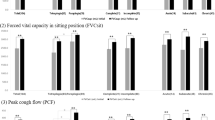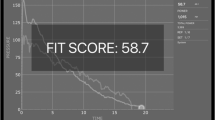Abstract
Study design
Randomised controlled trial with computerised allocation, assessor blinding and intention-to-treat analysis.
Objective
This study wanted to prove that cervicocranial flexion exercise (CCFE) and superficial neck flexor endurance training combined with common pulmonary rehabilitation is feasible for improving spinal cord injury people’s pulmonary function.
Setting
Taoyuan General Hospital, Ministry of Health and Welfare: Department of Physiotherapy, Taiwan.
Method
Thirteen individuals who had sustained spinal cord injury for less than a year were recruited and randomised assigned into two groups. The experimental group was assigned CCFEs and neck flexor endurance training plus normal cardiopulmonary rehabilitation. The control group was assigned general neck stretching exercises plus cardiopulmonary rehabilitation. Lung function parameters such as forced vital capacity (FVC), forced expiratory volume in 1 s (FEV1), FEV1/FVC, peak expiratory flow rate (PEFR), inspiratory capacity (IC), dyspnoea, pain, and neck stiffness were recorded once a week as short-term outcome measure.
Result
The experimental group showed significant time effects for FVC (pre-therapy: 80.4 ± 21.4, post-therapy: 86.9 ± 16.9, p = 0.021, 95% CI: 0.00–0.26) and PEFR (pre-therapy: 67.0 ± 33.4; post-therapy: 78.4 ± 26.9, p = 0.042, 95% CI: 0.00–0.22) after the therapy course. Furthermore, the experimental group showed significant time effects for BDI (experimental group: 6.3 ± 3.0; control group: 10.8 ± 1.6, p = 0.012, 95% CI: 0.00–0.21).
Conclusion
The exercise regime for the experimental group could efficiently increase lung function due to the following three reasons: first, respiratory accessory muscle endurance increases through training. Second, posture becomes less kyphosis resulting increasing lung volume. Third, the ratio between superficial and deep neck flexor is more synchronised.
IRB trial registration
TYGH108045.
Clinical trial registration
NCT04500223.
This is a preview of subscription content, access via your institution
Access options
Subscribe to this journal
Receive 1 print issues and online access
We are sorry, but there is no personal subscription option available for your country.
Buy this article
- Purchase on Springer Link
- Instant access to full article PDF
Prices may be subject to local taxes which are calculated during checkout

Similar content being viewed by others
Data availability
The datasets generated and/or analysed during the current study are not publicly available due the hospital’s policy but are available from the corresponding author upon reasonable request.
References
Burns AS, Marino RJ, Flanders AE, Flett H. Clinical diagnosis and prognosis following spinal cord injury. Handb Clin Neurol. 2012;109:47–62.
Brown R, DiMarco AF, Hoit JD, Garshick E. Respiratory dysfunction and management in spinal cord injury. Respir Care. 2006;51:853–68.
Mueller G, de Groot S, van der Woude L, Hopman MTE. Time-courses of lung function and respiratory muscle pressure generating capacity after spinal cord injury: a prospective cohort study. J Rehabil Med. 2008;40:269–76.
Fishburn MJ, Marino RJ, Ditunno Jr JF. Atelectasis and pneumonia in acute spinal cord injury. Arch Phys Med Rehabil. 1990;71:197–200.
Reines HD, Harris RC. Pulmonary complications of acute spinal cord injuries. Neurosurgery. 1987;21:193–6.
van den Berg MEL, Castellote JM, de Pedro-Cuesta J, Mahillo-Fernandez I. Survival after spinal cord injury: a systematic review. J Neurotrauma. 2010;27:1517–28.
Schilero GJ, Spungen AM, Bauman WA, Radulovic M, Lesser M. Pulmonary function and spinal cord injury. Respir Physiol Neurobiol. 2009;166:129–41.
Fawcett JW, Curt A, Steeves JD, Coleman WP, Tuszynski MH, Lammertse D, et al. Guidelines for the conduct of clinical trials for spinal cord injury as developed by the ICCP panel: spontaneous recovery after spinal cord injury and statistical power needed for therapeutic clinical trials. Spinal Cord. 2007;45:190–205.
Stepp EL, Brown R, Tun CG, Gagnon DR, Jain NB, Garshick E. Determinants of lung volumes in chronic spinal cord injury. Arch Phys Med Rehabil. 2008;89:1499–506. https://doi.org/10.1016/j.apmr.2008.02.018
Hopman MT, van der Woude LH, Dallmeijer AJ, Snoek G, Folgering HT. Respiratory muscle strength and endurance in individuals with tetraplegia. Spinal Cord. 1997;35:104–8.
Mateus SRM, Beraldo PS, Horan TA. Maximal static mouth respiratory pressure in spinal cord injured patients: correlation with motor level. Spinal Cord. 2007;45:569–75.
Liaw MY, Lin MC, Cheng PT, Wong MK, Tang FT. Resistive inspiratory muscle training: its effectiveness in patients with acute complete cervical cord injury. Arch Phys Med Rehabil. 2000;81:752–6.
Berlowitz DJ, Tamplin J. Respiratory muscle training for cervical spinal cord injury. Cochrane Database Syst Rev. 2013;7:CD008507.
Hart JE, Goldstein R, Walia P, Merilee T, Antonio L, Carlos GT, et al. FEV1 and FVC and systemic inflammation in a spinal cord injury cohort. BMC Pulm Med. 2017;17:113.
Garshick E, Mulroy S, Graves D, Greenwald K, Horton JA, Morse LR. Active lifestyle is associated with reduced dyspnea and greater life satisfaction in spinal cord injury. Arch Phys Med Rehabil. 2016;97:1721–7.
Sinderby C, Ingvarsson P, Sullivan L, Wickstrom I, Lindstrom L. Electromyographic registration of diaphragmatic fatigue during sustained trunk flexion in cervical cord injured patients. Paraplegia. 1992;30:669–77.
Taylor BJ, West CR, Romer LM. No effect of arm-crank exercise on diaphragmatic fatigue or ventilatory constraint in Paralympic athletes with cervical spinal cord injury. J Appl Physiol. 2010;109:358–66.
Van Houtte S, Vanlandewijck Y, Gosselink R. Respiratory muscle training in persons with spinal cord injury: a systematic review. Respir Med. 2006;100:1886–95.
Shin JC, Han EY, Cho KH, Im SH. Improvement in pulmonary function with short-term rehabilitation treatment in spinal cord injury patients. Sci Rep. 2019;9:17091.
Lin KH, Lai YL, Wu HD, Wang TQ, Wang YH. Cough threshold in people with spinal cord injuries. Phys Ther. 1999;79:1026–31.
Reid WD, Brown JA, Konnyu KJ, Rurak JME, Sakakibara BM. Physiotherapy secretion removal techniques in people with spinal cord injury: a systematic review. J Spinal Cord Med. 2010;33:353–70.
Viroslav J, Rosenblatt R, Tomazevic SM. Respiratory management, survival, and quality of life for high-level traumatic tetraplegics. Respir Care Clin N Am. 1996;2:313–22.
James WS III, Minh VD, Minteer MA, Moser KM. Cervical accessory respiratory muscle function in a patient with a high cervical cord lesion. Chest. 1977;71:59–64.
de Paleville DT, Lorenz D. Compensatory muscle activation during forced respiratory tasks in individuals with chronic spinal cord injury. Respir Physiol Neurobiol. 2015;217:54–62.
Falla D, Jull G, Hodges P, Vicenzino B. An endurance-strength training regime is effective in reducing myoelectric manifestations of cervical flexor muscle fatigue in females with chronic neck pain. Clin Neurophysiol. 2006;117:828–37.
Falla D, Jull G, Rainoldi A, Merletti R. Neck flexor muscle fatigue is side specific in patients with unilateral neck pain. Eur J Pain. 2004;8:71–7.
Borisut S, Vongsirinavarat M, Vachalathiti R, Sakulsriprasert P. Effects of strength and endurance training of superficial and deep neck muscles on muscle activities and pain levels of females with chronic neck pain. J Phys Ther Sci. 2013;25:1157–62.
Ghaderi F, Jafarabadi MA, Javanshir K. The clinical and EMG assessment of the effects of stabilization exercise on nonspecific chronic neck pain: a randomized controlled trial. J Back Musculoskelet Rehabil. 2017;30:211–9.
Jull G, Falla D. Does increased superficial neck flexor activity in the craniocervical flexion test reflect reduced deep flexor activity in people with neck pain? Man Ther. 2016;25:43–47.
Jull GA, Falla D, Vicenzino B, Hodges PW. The effect of therapeutic exercise on activation of the deep cervical flexor muscles in people with chronic neck pain. Man Ther. 2009;14:696–701.
McArdle WD, Katch VL, Katch FI. Exercise physiology: Energy, nutrition, and human performance (2nd ed., Vol. 468–474). Lippincott Williams and Wilkins (1996).
Witek TJ Jr, Mahler DA. Minimal important difference of the transition dyspnoea index in a multinational clinical trial. Eur Respir J. 2003;21:267–72.
Salaffi F, Stancati A, Silvestri CA, Ciapetti A, Grassi W. Minimal clinically important changes in chronic musculoskeletal pain intensity measured on a numerical rating scale. Eur J Pain. 2004;8:283–91.
Lee MH, Jang SH. The effects of the neck stabilization exercise on the muscle activity of trunk respiratory muscles and maximum voluntary ventilation of chronic stroke patients. J Back Musculoskelet Rehabil. 2019;32:863–8.
Campbell SC. A comparison of the maximum voluntary ventilation with the forced expiratory volume in one second: an assessment of subject cooperation. J Occup Med. 1982;24:531–3.
Falla D, Farina D. Neuromuscular adaptation in experimental and clinical neck pain. J Electromyogr Kinesiol. 2008;18:255–61.
Suvarnnato T, Puntumetakul R, Uthaikhup S, Boucaut R. Effect of specific deep cervical muscle exercises on functional disability, pain intensity, craniovertebral angle, and neck-muscle strength in chronic mechanical neck pain: a randomized controlled trial. J Pain Res. 2019;12:915–25.
Zafar H, Albarrati A, Alghadir AH, Iqbal ZA. Effect of different head-neck postures on the respiratory function in healthy males. Biomed Res Int. 2018;2018:4518269.
Bach JR. Mechanical insufflation-exsufflation. Comparison of peak expiratory flows with manually assisted and unassisted coughing techniques. Chest. 1993;104:1553–62.
Kang SW, Shin JC, Park CI, Moon JH, Rha DW, Cho DH. Relationship between inspiratory muscle strength and cough capacity in cervical spinal cord injured patients. Spinal Cord. 2006;44:242–8.
Deng G, Feinstein MB, Benusis L, Tin AL, Stover DE. Pilot study of self-care breath training exercise for reduction of chronic dyspnea. J Cardiopulm Rehabil Prev. 2019;39:56–9.
Author information
Authors and Affiliations
Contributions
CS was involved in study design; collected the data; performed the data analysis; wrote and revised the article. HT help data collection; wrote and revised the article. WL and YT were involved in experiment preparation; wrote and revised the article. All authors approved and read the final version of the article.
Corresponding author
Ethics declarations
Competing interests
The authors declare no competing interests.
Ethics
All the research process was supervised and approved by the institutional board of Taoyuan General Hospital (Trial number: TYGH108045). We followed all the institutional and government regulation about ethic of human volunteers during the process of the experiment.
Additional information
Publisher’s note Springer Nature remains neutral with regard to jurisdictional claims in published maps and institutional affiliations.
Rights and permissions
Springer Nature or its licensor (e.g. a society or other partner) holds exclusive rights to this article under a publishing agreement with the author(s) or other rightsholder(s); author self-archiving of the accepted manuscript version of this article is solely governed by the terms of such publishing agreement and applicable law.
About this article
Cite this article
Tsai, C.S., Li, HT., Yang, WL. et al. The effect of craniocervical flexion and neck endurance exercises plus pulmonary rehabilitation on pulmonary function in spinal cord injury: a pilot single-blinded randomised controlled trial. Spinal Cord Ser Cases 10, 27 (2024). https://doi.org/10.1038/s41394-024-00637-2
Received:
Revised:
Accepted:
Published:
DOI: https://doi.org/10.1038/s41394-024-00637-2



